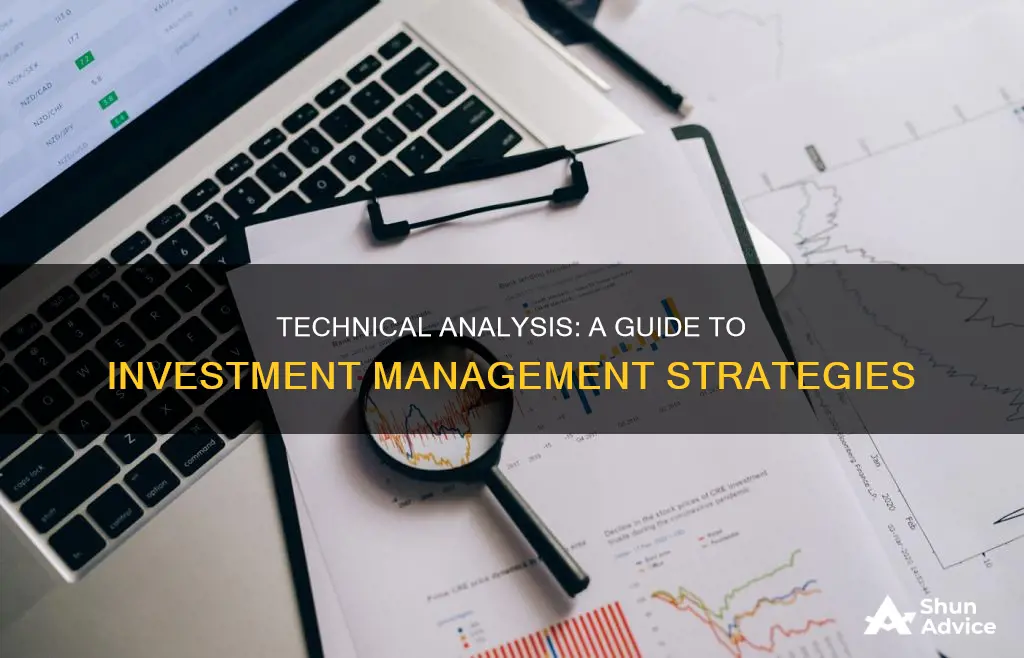
Technical analysis is a method used to evaluate statistical trends in trading activity, typically involving price movement and volume. It is used to identify trading and investment opportunities. Technical analysis is based on the assumption that past trading activity and a security's price changes can be valuable indicators of the security's future price movements. Technical analysts use charts, data, and statistics to uncover an investment's strengths or possible weaknesses and forecast trends to help analysts and investors decide if a security is viable.
| Characteristics | Values |
|---|---|
| Purpose | Predict the probable future price movement of a security |
| Data used | Market data, primarily price and volume |
| Time frames | 1-minute, 5-minute, 15-minute, hourly, 4-hour, daily, weekly, monthly, yearly |
| Technical indicators | Candlestick patterns, moving averages, pivots and Fibonacci numbers, momentum indicators |
| Chart types | Line charts, bar charts, candlestick charts |
| Volume | Number of shares or contracts traded over a given period |
| Trend | Direction of price movement (up, down, sideways) |
| Support | Low price range where buying activity prevents further decline |
| Resistance | Price range where selling activity prevents further rise |
| Momentum | Speed of price changes |
What You'll Learn

Technical analysis vs fundamental analysis
Technical analysis and fundamental analysis are two opposing schools of thought for evaluating investments and making trading decisions. Both aim to predict future price movements and identify profitable opportunities, but they take very different approaches.
Fundamental Analysis
Fundamental analysis evaluates securities by trying to measure their intrinsic value. It examines a company's financial statements, industry trends, economic indicators, and qualitative factors like the quality of management and competitive advantages. Fundamental analysts believe that by understanding a business's underlying health and potential, they can identify undervalued assets poised for growth. This approach is generally used by those looking for long-term value.
Technical Analysis
Technical analysis, on the other hand, focuses on statistical trends in a stock's price and volume over time. It evaluates financial assets by reviewing historical price and volume data, assuming that past trading activity and price changes can be valuable indicators of future price movements. Technical analysts, sometimes called chartists, use various indicators to predict future price movements. They believe that historical prices indicate market psychology, which can be used to predict trends. This approach is often used for short-term trading decisions.
Strengths and Weaknesses
Both fundamental and technical analysis have their strengths and weaknesses, and many investors combine aspects of both approaches to inform their decisions. Fundamental analysis can be time-consuming and may not always account for investor psychology and market trends, while technical analysis has been criticised for its subjectivity and potential overfitting. However, technical analysis can provide a quick, visual way to evaluate assets, and fundamental analysis may overlook short-term price trends and patterns.
In conclusion, fundamental analysis and technical analysis offer different perspectives and are more or less valuable depending on the context and investment goals. Fundamental analysis is often used for long-term investment strategies, while technical analysis is useful for short-term trading decisions. Ultimately, the choice between the two depends on factors such as trading style, investment horizon, and financial objectives.
Retirement Investments: Strategies for Effective Money Management
You may want to see also

Using charts to identify trading signals and price patterns
Technical analysts using charts search for archetypal price chart patterns, such as the well-known head and shoulders or double top/bottom reversal patterns, study technical indicators, moving averages and look for forms such as lines of support, resistance, channels and more obscure formations such as flags, pennants, balance days and cup and handle patterns.
Volume is an important element of technical analysis and is often included on charts. It can be viewed as a confirmation that indicates the strength or conviction of buyers and sellers in determining a security’s price.
The two primary variables for technical analysis are the time frames considered and the particular technical indicators that a trader chooses to utilize. The time frame a trader selects to study is typically determined by that individual trader’s personal trading style. Intra-day traders, for example, favour analysing price movement on shorter time frame charts, such as the 5-minute or 15-minute charts.
There are several types of charts that technical analysts examine, including candlestick charts, line charts and bar charts. Candlestick charting is the most commonly used method of showing price movement on a chart. A candlestick is formed from the price action during a single time period for any time frame.
Technical analysts also use market indicators of many sorts, some of which are mathematical transformations of price, often including up and down volume, advance/decline data and other inputs. These indicators are used to help assess whether an asset is trending, and if it is, the probability of its direction and of continuation.
Technical analysis charts can be used to identify relative strength, trend, consolidation, support, resistance, and change in polarity.
Support is defined as a low price range in which the price stops declining because of buying activity. It is the opposite of resistance, which is a price range in which price stops rising because of selling activity.
Chart patterns are formations appearing on price charts that create some type of recognizable shape. There are two major types of chart patterns: reversal patterns and continuation patterns. Reversal patterns signal the end of a trend, while continuation patterns indicate that a market trend that was in place prior to the pattern formation will continue once the pattern is completed.
Technical indicators are used to derive additional information from basic chart patterns. An indicator is any measure based on price, market sentiment, or fund flows that can be used to predict changes in price. Mathematically calculated indicators usually have a supply and demand underpinning. Basic types of indicators include price-based indicators, momentum oscillators, and sentiment indicators.
Crafting an Effective Investment Portfolio Presentation
You may want to see also

The top-down approach
Step 1: Global View
The first step is to assess the state of the global economy, including both developed and emerging countries. Investors often use gross domestic product (GDP) growth rates as a benchmark to compare the economic performance of different countries. It is also crucial to consider geopolitical tensions and their potential impact on financial stability. By analysing these factors, investors can determine which regions offer a favourable risk-reward ratio.
Step 2: Macro Trends and Technical Analysis
This step involves using charts and technical analysis to evaluate the macro trends in specific countries. By examining long-term charts of economic indicators and broad stock market indices, investors can identify countries with strong economic and market performance worth further analysis.
Step 3: US Economy and Stock Market Analysis
As the world's largest economy, the United States warrants a dedicated analysis. Investors examine economic indicators such as interest rates, inflation, and employment data to assess the strength of the US economy and stock market. This step helps determine the overall market sentiment and provides insights into potential investment opportunities.
Step 4: Major US Stock Indexes Analysis
Investors then turn their attention to major US stock indexes, such as the S&P 500 and Nasdaq. Both fundamental and technical analysis are employed to gauge the robustness of these indices. Fundamental analysis considers ratios like price-to-earnings, price-to-sales, and dividend yields, while technical analysis helps determine the market's position within the long-term cycle.
Step 5: Microanalysis and Sector Selection
The microanalysis phase involves narrowing down the focus to specific sectors. Investors analyse the strengths and weaknesses of different sectors, such as healthcare, technology, and mining, to identify those with the best long-term prospects. This process may involve fundamental and technical analysis, similar to the approach used in the previous steps.
Step 6: Individual Stock Selection
Finally, investors drill down to the level of individual stocks within the selected sectors. Fundamental analysis is applied to assess the financial health and growth potential of specific companies. Technical analysis is also used to identify entry prices, focusing on long-term weekly and daily charts.
Benefits of the Top-Down Approach
Proponents of the top-down approach argue that it helps investors determine an ideal asset allocation for their portfolios, regardless of market conditions. It can prevent over-investing in equities during a bear market, reducing portfolio risk. Additionally, the top-down approach promotes diversification across sectors and leading foreign markets, resulting in a well-balanced portfolio.
Drawbacks of the Top-Down Approach
One drawback of the top-down approach is the potential for incorrect analysis, leading to missed investment opportunities. For example, if the analysis suggests a bearish market, investors may reduce their exposure to equities, potentially missing out on gains if the market rallies. Additionally, the top-down approach may result in under-investment in a bull market, which can be costly in the long run. The elimination of entire sectors from the analysis may also cause investors to overlook promising individual stocks within those sectors.
A Guide to Investing in Managed Funds
You may want to see also

The bottom-up approach
Technical analysis is a method of evaluating statistical trends in trading activity, typically involving price movement and volume. It is used to identify trading and investment opportunities. Technical analysis is used to evaluate price trends and patterns and is often contrasted with fundamental analysis, which focuses on a company's financials rather than historical price patterns or stock trends.
In addition to financial analysis, the bottom-up approach involves assessing the quality of a company's management, its competitive position, and its product or service offerings. Investors analyze factors such as the company's strategic initiatives, market share, and innovation capabilities to gauge long-term growth prospects.
Bottom-up investors usually employ long-term, buy-and-hold strategies that rely on fundamental analysis. This gives them a deep understanding of a single company and its stock, providing insight into an investment's long-term growth potential.
Overall, the bottom-up approach to technical analysis is a valuable tool for investors who want to focus on individual companies and their fundamentals, rather than starting with macroeconomic factors.
Asset Managers: Where Do They Invest Their Money?
You may want to see also

Limitations of technical analysis
Technical analysis is a method of evaluating financial assets like stocks, bonds, and commodities using mathematical calculations based on historical price and volume data. While it is widely used and accepted, it has several limitations:
Limited Usefulness for Illiquid Securities:
Technical analysis is most effective in liquid markets. It has limited usefulness for illiquid securities, where a small trade can significantly impact prices. In such cases, a large trade could cause a substantial price change, deviating from the predicted trend.
Subjectivity in Interpretation:
Technical analysis involves interpreting charts and indicators, which can be subjective. While certain aspects, like indicator calculations, follow specific rules, the interpretation of findings often depends on the individual analyst's style and approach. This subjectivity can lead to varying predictions from the same data.
Short-Term Focus:
Technical analysis is more effective for predicting daily or short-term performance. It is less helpful for long-term predictions, where fundamental analysis, which considers a company's financial health and market conditions, is often more effective.
Self-Fulfilling Prophecy:
A criticism of technical analysis is that it can become a self-fulfilling prophecy. For example, if many traders place stop-loss orders at a certain level, a large number of sell orders will be triggered if the stock reaches this price, pushing the price down and confirming the anticipated movement. However, this short-term selling pressure may not significantly impact the asset's price over the long term.
Historical Repetition:
Technical analysis assumes that price patterns and trends will repeat themselves due to investor behaviour and psychology. However, critics argue that history does not repeat itself exactly, so the study of price patterns may not be as important as assumed. Prices are sometimes better modelled as a random walk.
Misinterpretation and Low Volume:
Charts can be misinterpreted, and formations may be based on low trading volume. Additionally, the periods chosen for moving averages may not be optimal for the specific trade being considered. These factors can lead to inaccurate predictions.
Who Is an Institutional Investment Manager and What Do They Do?
You may want to see also







